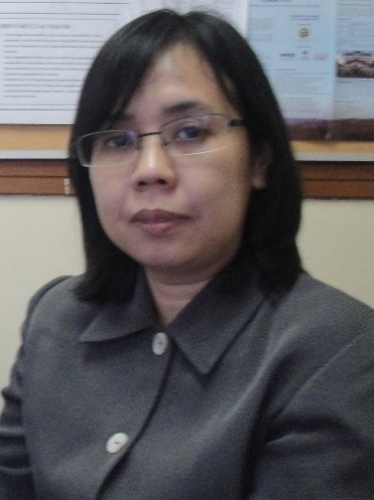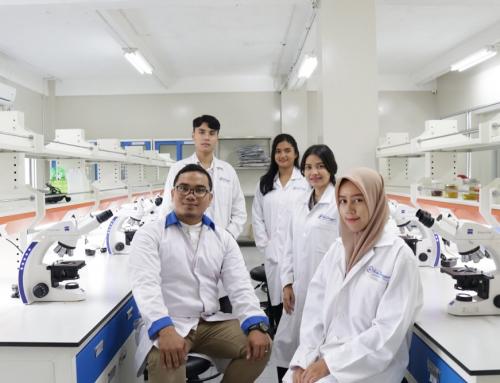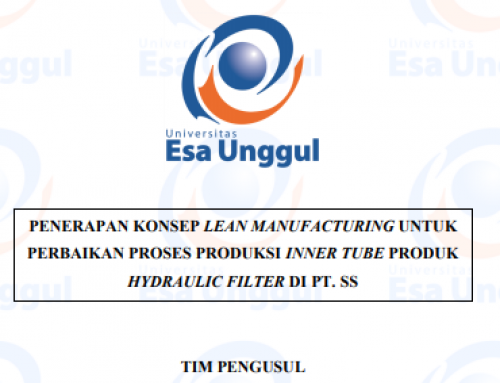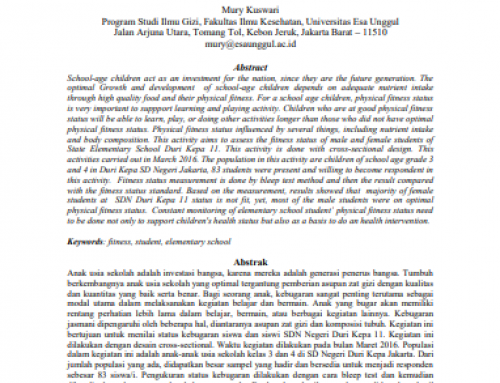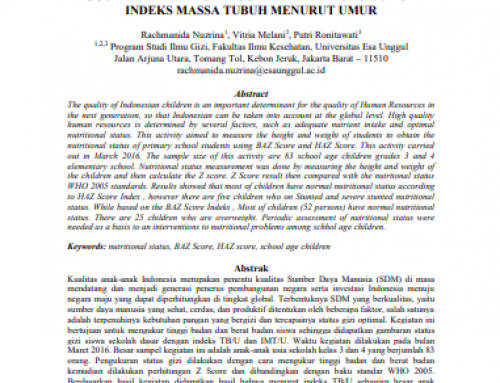
Dr. Lily Amelia
Dosen Fakultas Teknik
Universitas Esa Unggul
Abstract
The production of crude palm oil and palm kernel is a complex problem due to the influence of processing variables and environmental factors. These processing variables influence the amount of crude palm oil and palm kernel losses during processing. Instead of mathematical model, fuzzy logic approach provides a simpler and easier mechanism to describe the relationships between the processing variables and the amount of crude palm oil and palm kernel losses. In this study, four fuzzy expert system models were developed for each palm oil processing station. An approximation of centre of gravity method for defuzzification is also proposed to enable the development of the model using Microsoft_Excel. For comparison purpose, the models were also developed using MATLAB_. Results obtained from the Excel model are found to be very close to the results from MATLAB.
Introduction
Palm oil is one of the main commodities in Malaysia and Indonesia that gives high significant contributions to their national incomes. Both two countries are the biggest producers and exporters of crude palm oil (CPO) in the world. Malaysia produces 15.9 million tonnes of CPO in 2006 (Malaysian Palm Oil Board., 2008), followed by Indonesia that produces 15.8 million tonnes in that year. The total exports of crude palm oil from Malaysia is around 14.42 million tonnes in 2006 and 13.74 million tonnes in 2007 (Malaysian Palm Oil Board, 2008). While, Indonesia exports 11.3 million tonnes of crude palm oil in 2006 (Siagian, 2008). Therefore, the importance of research related to how to increase palm oil production become major interest for government as well as palm oil producers in both two countries.
In a palm oil production, objectives that are of interest to the decision makers are to maximise crude palm oil and kernel production, to minimise palm oil and palm kernel losses during processing and to maintain production costs at the lowest possible level (Eng & Tat, 1985). Nevertheless, the production of crude palm oil and palm kernel is a complex problem due to the influence of processing variables and environmental factors. Existing problems in the processing of crude palm oil and palm kernel are the lack of processing efficiencies, the properties of the raw materials that cause them to deteriorate easily, delay in processing, etc. These factors may affect the quantity and quality of oil and kernel production as well as giving impact to the production costs. One of the main concerns of palm oil mills is how to minimise the palm oil and palm kernel losses during processing. These losses occur almost in all processing station such as sterilising and threshing station, digesting and pressing station, clarification and kernel station. The relationship between the amount of palm oil and palm kernel losses and the processing variables that influences those losses in each station is very complex and difficult to describe through a mathematical model. Instead of using mathematical model, this relationship can also be constructed using fuzzy logic approach. As a qualitative approach, fuzzy logic provides a methodology to mimic human expert and allow the use of data and information from expert knowledge. Fuzzy logic also provides an easier and simpler mechanism in developing the model due to its nature that allow decision making process that involves a vague, imprecise, incomplete and ambiguous information.
The application of fuzzy logic expert system in the production process control and optimisation have been widely used since Mamdani and Assilian (1975) developed fuzzy inference fuzzy logic controller model for a steam engine. Mamdani fuzzy logic expert system has been applied in the area of production optimisation and control in the food processing industries as well as other industries. For example, application of fuzzy expert control for hydraulic forging machine (Lee & Kopp, 2001) and twin extruder machine (Lee, Hong, Han, Kang, & Kwon, 2002). Peres, Guerra, Alique and Ros (1999) also developed fuzzy control model for milling process optimisation and Vagelatos, Rigatos, and Tzafestas (2001) developed fuzzy control model for optimising the injection molding process. Other applications include optimization of power distribution system operations that was developed by Sarfi and Solo (2002), food frying process (Rywotycki, 2003) and fuzzy expert control for oil and gas supplies (Neuroth, McConnell, Stronach, & Vamplew, 2000). Despite the wide application of fuzzy expert system, the technique has yet to be applied in the crude palm oil production.
In this study, fuzzy expert models are developed in the area of palm oil production to describe the relationship between palm oil and kernel losses and the processing variables that influence those losses during the processing. The fuzzy expert models use Mamdani approach and are developed based on knowledge of decision makers and experts in palm oil processing. Most of fuzzy expert system models are developed using Mamdani approach. Liao (2003) noted that compared to TSK (Takagi-Sugeno-Kang) model, the Mamdani approach is better for discovery of human understandable knowledge from real world problem.
References
Eng, G. E., & Tat, M. M. (1985). Quality control in fruit processing. JAOCS, 62(2), 274–281.
Hartley, C. W. S. (1977). The oil palm (2nd ed). New York: Longman.
Jang, J. R., Sun, C. T., & Mizutani, E. (1997). Neuro fuzzy and soft computing. New York:Prentice Hall, Inc.
Lee, S. J., Hong, C. G., Han, T. S., Kang, J. Y., & Kwon, Y. A. (2002). Application of fuzzy control to start up of twin screw extruder. Food Control, 13(4–5), 301–306.
Lee, Y. H., & Kopp, R. (2001). Application of fuzzy control for a hydraulic forging machine. Fuzzy Sets and Systems, 118(1), 99–108.
Liao, T. W. (2003). Classification of welding flaw types with fuzzy expert systems. Expert System with Application, 25, 101–111.
Malaysian Palm Oil Board. (2008). Overview of the Malaysian oil palm industry 2007. (http://www.econ.mpob.gov.my/economy/overview07.htm).
Mamdani, E. H., & Assilian, S. (1975). An experiment in linguistic synthesis with a fuzzy logic controller. Man Machine Studies, 7(1), 1–13.
Naibaho, P. M. (1998). Teknologi pengolahan kelapa sawit. Medan: Pusat Penelitian Kelapa Sawit Medan.
Neuroth, M., McConnell, P., Stronach, F., & Vamplew, P. (2000). Improved modeling and control of oil and gas transport facility operations using artificial and intelligence. Knowledge Based Systems, 13(2–3), 81–92.
Peres, C. R., Guerra, R. E. H., Alique, R. H. H. A., & Ros, S. (1999). Fuzzy model and hierarchical fuzzy control integration: An approach for milling process optimization. Computers in Industry, 39(3), 199–207.
Rywotycki, R. (2003). Food frying process control system. Journal of Food Engineering, 59(4), 339–342.
Sarfi, R. J., & Solo, A. M. G. (2002). Network radiality, parameter and performance heuristics in optimization of power distribution system operations part 2:
Fuzzification of rule base. Electrical Power and Energy Systems, 24(8), 683–692.
Siagian, V. (2008). Harga minyak goreng diserahkan ke pasar. Suara Pembaruan Daily. (http://www.suarapembaruan.com/News/2008/05/06/Editor/edit01.htm).
Vagelatos, G. A., Rigatos, G. C., & Tzafestas, S. G. (2001). Incremental fuzzy supervisory controller design for optimizing the injection molding process.
Expert Systems with Applications, 20, 207–216.

